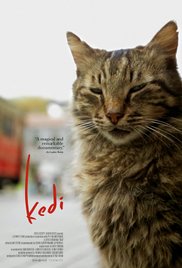
 Grade: A-
Grade: A-
Verdict: It’s moving and slyly profound. And it’s about cats. What more could you want?
This film is being billed at Landmark Midtown as “Nine Lives: The Cats of Istanbul.” It’s a horrible title, I think, missing the simple beauty of its true title (“Kedi” is Turkish for “Cat”). Forget all this nine lives nonsense– “Kedi” isn’t interested in such feline stereotypes! It’s interested in cats, and it’s interested in Istanbul, and how those cats enchant its citizens.
Istanbul is full of cats. Be they roaming alleyways, harassing fish vendors or fighting each other for street cred, they’re everywhere and thoroughly entrenched in every resident’s life. “Kedi” picks a few favorites: there’s the combative and jealous Psycho, a rough n’ tumble fighter, several sweet mothers with kittens in tow, a gentleman who lives at a restaurant but never bothers the guests. Director Ceyda Torun follows them throughout their daily lives, trotting from place to place for food provided by adopted parents who relish their company while it lasts.
The humans in the story are secondary to the cats, of course, but provide a lot of the film’s casual revery. These people don’t “own” the cats, but they care for them nonetheless. Every interviewee has some sense of their inherent goodness, as spiritually sound or conduits of good vibes, or simply as amusing or loving presences. One man tells the story of a cat who found him in the midst of a financial crisis and helped him find an abandoned wallet holding just enough money to get him through. Another woman talks of the importance of cats for dispelling negative energy. They all cherish these cats, caring for them with no pre-requisites or expectations. In this sense, “Kedi” gives us a touching portrait of selflessness and unconditional love.
And that’s just the people. The cats themselves are a whole other story. Cinematographers Charlie Wuppermann and Alp Korfali follow them with amazing precision, somehow managing to lurk behind them with smooth-moving cameras low to the ground, at perfect cat level. There’s no performance, exactly, just cats being cats, but they each have a story. As the humans love to point out, each of these felines has his or her own personality, and the sweetest moments of the film come when those personalities emerge.
Framing all of this is the city itself. We can understand that it’s changing, that other things are happening in the background that are never developed. Tall buildings are going up, ways of life are being shaken. The film occasionally skirts the edge “politics”– one woman talks about how hard it is to be a woman in Istanbul and cites the cats as a necessary reminder of positive femininity, while a family worried about losing their building and frets about who will take care of the cats if the neighborhood is bulldozed.
But “Kedi” is careful never to leap into political whitenoise, and is all the better for it. The story is the cats, their humans and the community they all share. Things change, things are ruined, things suck, but “Kedi” finds a beautiful spirit in these roaming cats, in their freedom, in the healing and joy they bring and, of course, the good they bring out in us.
